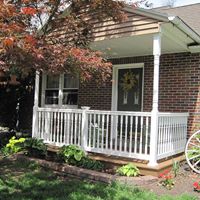Nancy A Reichert
age ~69
from Starkville, MS
- Also known as:
-
- Nancy Dr Reichert
- Nancy Baldwin
- Reichert A Nancy
- Phone and address:
-
2184 Houston Thompson Rd, Starkville, MS 39759
6623247337
Nancy Reichert Phones & Addresses
- 2184 Houston Thompson Rd, Starkville, MS 39759 • 6623247337
- 825 Houston Thompson Rd, Starkville, MS 39759
- Mc Farland, WI
- Las Cruces, NM
- 825 Houston Thompson Rd, Starkville, MS 39759 • 6623247337
Work
-
Company:Mississippi state university
-
Address:Mississippi State Univ, MS State Univ, MS 39762
-
Phones:6623252323
-
Position:Professor and head biological sciences
-
Industries:Colleges, Universities, and Professional Schools
Education
-
Degree:High school graduate or higher
Us Patents
-
Soilless Sod
view source -
US Patent:6357176, Mar 19, 2002
-
Filed:Mar 19, 1997
-
Appl. No.:08/825550
-
Inventors:Brian S. Baldwin - Mississippi State MS
Marty J. Fuller - Mississippi State MS
Nancy A. Reichert - Mississippi State MS
Kevin L. Hensler - Mississippi State MS -
Assignee:Mississippi State University - Mississippi State MS
-
International Classification:A01C 104
-
US Classification:47 56
-
Abstract:A soil- and grass seed-less sod precursor containing a non-woven bio-cellulosic fiber mat and grass sprigs. The sod precursor can be used to produce a soil-free sod which is useful for manufacturing athletic fields, golf courses and lawns.
-
Method For Transformation Of Cotton And Organogenic Regeneration
view source -
US Patent:6479287, Nov 12, 2002
-
Filed:May 1, 2000
-
Appl. No.:09/562193
-
Inventors:Nancy A. Reichert - Starkville MS
Teong-Kwee Lim - Johor, MY
Margaret M. Young - Falmouth, JM -
Assignee:Mississippi State University - Mississippi State MS
-
International Classification:C12N 502
-
US Classification:435427, 435430, 4354301, 435431
-
Abstract:Protocols for organogenic regeneration of cotton are provided, which makes the in vitro regeneration of mature fertile plants in a reduced amount of time possible. Seedlings are the basis for monocotyl or hypocotyl explants which are transferred from the germination medium to a shoot initiation medium which comprises AgNO. These explants, prior to shoot initiation, may be transformed with exogenous DNA, either through inoculation with an Agorbacterium agent such as A. tumefaciens, or through biolistic bombardment of the explants with microprojectiles having the exogenous DNA adsorbed onto their surface.
-
Methods For Maize Transformation Coupled With Adventitious Regeneration Utilizing Nodal Section Explants And Mature Zygotic Embryos
view source -
US Patent:6570068, May 27, 2003
-
Filed:Oct 30, 2000
-
Appl. No.:09/698080
-
Inventors:Margaret M. Young - Trelawny, JM
Nancy A. Reichert - Starkville MS -
Assignee:Mississippi State University - Mississippi State MS
-
International Classification:A01H 100
-
US Classification:800293, 800278, 800300, 8003001, 8003201, 435470, 435440, 435419, 435430, 435431
-
Abstract:Maize tissue may be regenerated from nodal extracts prepared from germinated mature seeds and germinated embryos grown in a medium containing plant growth regulators. Nodal section explants are secured from seedlings approximately 3-10 days old, preferably from 3-7 days old. The explants are grown on an induction medium until adventitious shoot formation is observed. The shoots are separated and elongated on an MS-based medium, and then rooted. Fast genotype-independent regeneration is obtained, in 12-14 weeks. These explants, as well as zygotic embryos, may be transformed with exogenous DNA using a biolistic approach, where DNA precipitated onto tungsten microprojectiles is accelerated at a minimum of 650 psi towards the explants at a distance of at least 7. 5 cm. Improved frequency of transformation is obtained using microprojectiles which prior to DNA precipitation were frozen in glycerol, and suspending from a preparation of 2. 5 M CaCl. The combination of transformation process and regeneration can be used, independent of genotype, to provide new commercial crop organisms.
-
Nematode-Upregulated Peroxidase Gene Promoter From Nematode-Resistant Maize Line Mp307
view source -
US Patent:6703541, Mar 9, 2004
-
Filed:Nov 21, 2000
-
Appl. No.:09/716410
-
Inventors:Linas S. Padegimas - Starkville MS
Nancy A. Reichert - Starkville MS -
Assignee:Mississippi State University - Mississippi State MS
-
International Classification:C12N 1509
-
US Classification:800279, 800278, 800287, 8003201, 800288, 435419, 435468, 4353201, 536 236, 536 232, 536 237, 536 241
-
Abstract:The present invention provides a nematode inducible promoter sequence from maize inbred line Mp307, and DNA constructs and transcription cassettes comprising said promoter sequence, a gene encoding a toxin, and a termination sequence. Methods for inducing nematode resistance in plants and transgenic plants resistant to nematode infection are also provided.
-
Methods For Maize Transformation Coupled With Adventitious Regeneration Utilizing Nodal Section Explants And Mature Zygotic Embryos
view source -
US Patent:61405558, Oct 31, 2000
-
Filed:Jun 5, 1998
-
Appl. No.:9/092180
-
Inventors:Nancy A. Reichert - Starkville MS
Vanishree Rudraswamy - Starkville MS -
Assignee:Mississippi State University - Mississippi State MS
-
International Classification:A01H 400
A01H 100
C12N 504
C12N 1582
C12N 1587 -
US Classification:800293
-
Abstract:Maize tissue may be regenerated from nodal extracts prepared from germinated mature seeds and germinated embryos. Nodal section explants are secured from seedlings in 3-5 days. The explants are grown on an induction medium until adventitious shoot formation is observed. The shoots are separated and elongated on an MS-based medium, and then rooted. Fast genotype-independent regeneration is obtained, in 12-14 weeks. These explants, as well as zygotic embryos, may be transformed with exogenous DNA using a biolistic approach, where DNA precipitated onto tungsten microprojectiles is accelerated as 650 psi towards the explants at a distance of at least 7. 5 microns. Improved frequency of transformation is obtained using microprojectiles which prior to DNA precipitation were frozen in glycerol, and suspending from a preparation of 2. 5 M CaCl. sub. 2. The combination of transformation process and regeneration can be used, independent of genotype, to provide new commercial crop organisms.
-
Methods For Genotype-Independent Nuclear And Plastid Transformation Coupled With Clonal Regeneration Utilizing Mature Zygotic Embryos In Rice (Oryza Sativa) Seeds
view source -
US Patent:61538132, Nov 28, 2000
-
Filed:Dec 11, 1998
-
Appl. No.:9/209466
-
Inventors:Nancy A. Reichert - Mississippi State MS
Vanishree Rudraswamy - Mississippi State MS
Liza Ming-Ju Chen - Starkville MS -
Assignee:Mississippi State University - Mississippi State MS
-
International Classification:A07H 100
C12N 1529
C12N 1582
C12N 1500
A01H 106 -
US Classification:800293
-
Abstract:A method for transforming rice plants to express heterologous DNA which involves the biolistic bombardment of mature rice seeds (embryo bearing) and results in expression of the heterologous DNA coated on the biolistic particle in the post-bombardment embryo. The heterologous DNA may be introduced as a plastid, as opposed to bare DNA. The transformed rice embryo is regenerated into a rice plantlet which can be transferred from greenhouse to field.
-
Soybean Transformation And Regeneration Methods
view source -
US Patent:59688300, Oct 19, 1999
-
Filed:Mar 28, 1997
-
Appl. No.:8/825469
-
Inventors:Yinghui Dan - Mississippi State MS
Nancy A. Reichert - Mississippi State MS -
Assignee:Mississippi State University - Mississippi State MS
-
International Classification:C12N 510
C12N 1582
A01H 500 -
US Classification:435469
-
Abstract:A method of transforming and regenerating soybean plants relies on selection of hypocotyl explants as the target material. Hypocotyl explants can be transformed either by microparticle bombardment with DNA-coated microparticles of inert metals, or by co-culturing with an Agrobacterium strain. The transformed explants can be successfully regenerated, using a protocol including culturing on a shoot induction medium, followed by transfer to a shoot elongation medium to form rooted plantlets, which are transplanted to soil.
-
Method For Transformation Of Cotton And Kenaf And Organogenic Regeneration
view source -
US Patent:59982071, Dec 7, 1999
-
Filed:Jun 12, 1998
-
Appl. No.:9/096360
-
Inventors:Nancy A. Reichert - Starkville MS
Teong-Kwee Lim - Johor, MY
Margaret M. Young - Starkville MS -
Assignee:Mississippi State University - Mississippi State MS
-
International Classification:A01H 400
A01H 100
C12N 1582
C12N 1584 -
US Classification:435430
-
Abstract:Protocols for ogranogenic regeneration of cotton and kenaf are provided, which makes the in vitro regeneration of mature fertile plants in a reduced amount of time possible. Seedlings are the basis for monocotyl or hypocotyl explants which are transferred from the germination medium to a shoot initiation medium which comprises AgNO. sub. 3. These explants, prior to shoot initiation, may be transformed with exogenous DNA either through inoculation with a Agrobacterium agent such as A. tumefaciens, or through biolistic bombardment of the explants with microprojectiles having the exogenous DNA adsorbed onto their surface.
Name / Title
Company / Classification
Phones & Addresses
Professor And Head Biological Sciences
Mississippi State University
Colleges, Universities, and Professional Scho...
Colleges, Universities, and Professional Scho...
Mississippi State Univ, MS State Univ, MS 39762
Assistant Vice President Administrative Assistant Adm Intern Office Of The Provost
Mississippi State University
Colleges, Universities, and Professional Scho...
Colleges, Universities, and Professional Scho...
Mississippi State Univ, MS State Univ, MS 39762
Manager
Biological Sciences
Colleges, Universities, and Professional Scho...
Colleges, Universities, and Professional Scho...
Po Box Gy, MS State Univ, MS 39762
Website: msstate.edu
Website: msstate.edu
Assistant Vice President For Academic Affairs And Professor Departments Of Plant And Soil Sciences And Biochemistry And Molecul
Mississippi State University
Colleges, Universities, and Professional Scho...
Colleges, Universities, and Professional Scho...
Mississippi State Univ, MS State Univ, MS 39762
Resumes

Nancy Reichert
view source
Nancy Reichert
view source
Nancy Reichert
view source
Nancy Reichert
view source
Nancy Reichert
view source
Nancy Reichert
view source
Nancy Reichert
view sourceLicense Records
Nancy J Reichert
License #:
RS101438A - Expired
Category:
Real Estate Commission
Type:
Real Estate Salesperson-Standard
Classmates

Nancy Reichert (Binch)
view sourceSchools:
Souderton High School Souderton PA 1971-1975
Community:
Kevin Mckeever

Nancy Chambers (Reichert)
view sourceSchools:
Inland Lakes High School Indian River MI 1972-1976

Nancy Reichert
view sourceSchools:
All Saints School Cincinnati OH 1946-1950
Community:
Stephen Johnson, Jean Boyer

Nancy Reichert
view sourceSchools:
Coon High School Wilson NC 1947-1951
Community:
Jim Reece, Mike Mclendon

Nancy Reichert | Muscatin...
view source
East Carolina University ...
view sourceGraduates:
Nancy Reichert (1951-1954),
Steve Barbour (1976-1981),
Debbie Seykora (1992-1994),
Tracie Simpson (1998-1999)
Steve Barbour (1976-1981),
Debbie Seykora (1992-1994),
Tracie Simpson (1998-1999)

Smith College - Social Wo...
view sourceGraduates:
Nancy Reichert (1988-1992),
John Green (1971-1974),
Kacey Booth (1992-1996),
Michael Chase (1994-1998),
Janet Taksa (1961-1965)
John Green (1971-1974),
Kacey Booth (1992-1996),
Michael Chase (1994-1998),
Janet Taksa (1961-1965)

All Saints School, Cincin...
view sourceGraduates:
Nancy Reichert (1946-1950),
Liz Glassmeyer (1973-1977),
Elizabeth David (1978-1979),
Daniel Tappel (1972-1976),
Tim Herschede (1956-1964)
Liz Glassmeyer (1973-1977),
Elizabeth David (1978-1979),
Daniel Tappel (1972-1976),
Tim Herschede (1956-1964)
Youtube
Plaxo

Nancy Reichert
view sourceFlickr
Myspace

Nancy reichert
view source
Nancy Reichert
view source
Nancy Reichert
view source
Nancy Reichert
view source
Nancy Reichert Arlin
view source
Nancy Reichert Crawford
view source
Nancy Reichert
view source
Nancy Reichert
view source
Nancy Reichert Wandtke
view sourceGet Report for Nancy A Reichert from Starkville, MS, age ~69








